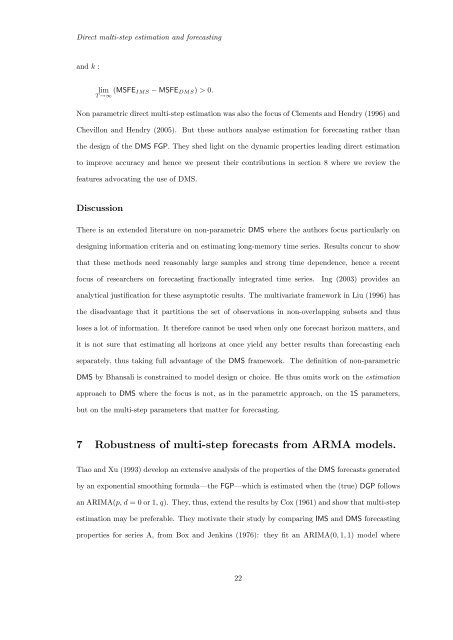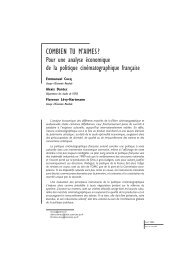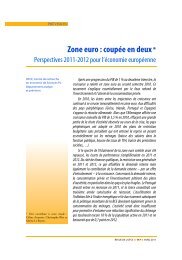direct multi-step estimation and forecasting - OFCE - Sciences Po
direct multi-step estimation and forecasting - OFCE - Sciences Po
direct multi-step estimation and forecasting - OFCE - Sciences Po
Create successful ePaper yourself
Turn your PDF publications into a flip-book with our unique Google optimized e-Paper software.
Direct <strong>multi</strong>-<strong>step</strong> <strong>estimation</strong> <strong>and</strong> <strong>forecasting</strong><br />
<strong>and</strong> k :<br />
lim (MSFE IMS − MSFE DMS ) > 0.<br />
T →∞<br />
Non parametric <strong>direct</strong> <strong>multi</strong>-<strong>step</strong> <strong>estimation</strong> was also the focus of Clements <strong>and</strong> Hendry (1996) <strong>and</strong><br />
Chevillon <strong>and</strong> Hendry (2005). But these authors analyse <strong>estimation</strong> for <strong>forecasting</strong> rather than<br />
the design of the DMS FGP. They shed light on the dynamic properties leading <strong>direct</strong> <strong>estimation</strong><br />
to improve accuracy <strong>and</strong> hence we present their contributions in section 8 where we review the<br />
features advocating the use of DMS.<br />
Discussion<br />
There is an extended literature on non-parametric DMS where the authors focus particularly on<br />
designing information criteria <strong>and</strong> on estimating long-memory time series. Results concur to show<br />
that these methods need reasonably large samples <strong>and</strong> strong time dependence, hence a recent<br />
focus of researchers on <strong>forecasting</strong> fractionally integrated time series.<br />
Ing (2003) provides an<br />
analytical justification for these asymptotic results. The <strong>multi</strong>variate framework in Liu (1996) has<br />
the disadvantage that it partitions the set of observations in non-overlapping subsets <strong>and</strong> thus<br />
loses a lot of information. It therefore cannot be used when only one forecast horizon matters, <strong>and</strong><br />
it is not sure that estimating all horizons at once yield any better results than <strong>forecasting</strong> each<br />
separately, thus taking full advantage of the DMS framework. The definition of non-parametric<br />
DMS by Bhansali is constrained to model design or choice. He thus omits work on the <strong>estimation</strong><br />
approach to DMS where the focus is not, as in the parametric approach, on the 1S parameters,<br />
but on the <strong>multi</strong>-<strong>step</strong> parameters that matter for <strong>forecasting</strong>.<br />
7 Robustness of <strong>multi</strong>-<strong>step</strong> forecasts from ARMA models.<br />
Tiao <strong>and</strong> Xu (1993) develop an extensive analysis of the properties of the DMS forecasts generated<br />
by an exponential smoothing formula—the FGP—which is estimated when the (true) DGP follows<br />
an ARIMA(p, d = 0 or 1, q). They, thus, extend the results by Cox (1961) <strong>and</strong> show that <strong>multi</strong>-<strong>step</strong><br />
<strong>estimation</strong> may be preferable. They motivate their study by comparing IMS <strong>and</strong> DMS <strong>forecasting</strong><br />
properties for series A, from Box <strong>and</strong> Jenkins (1976): they fit an ARIMA(0, 1, 1) model where<br />
22








